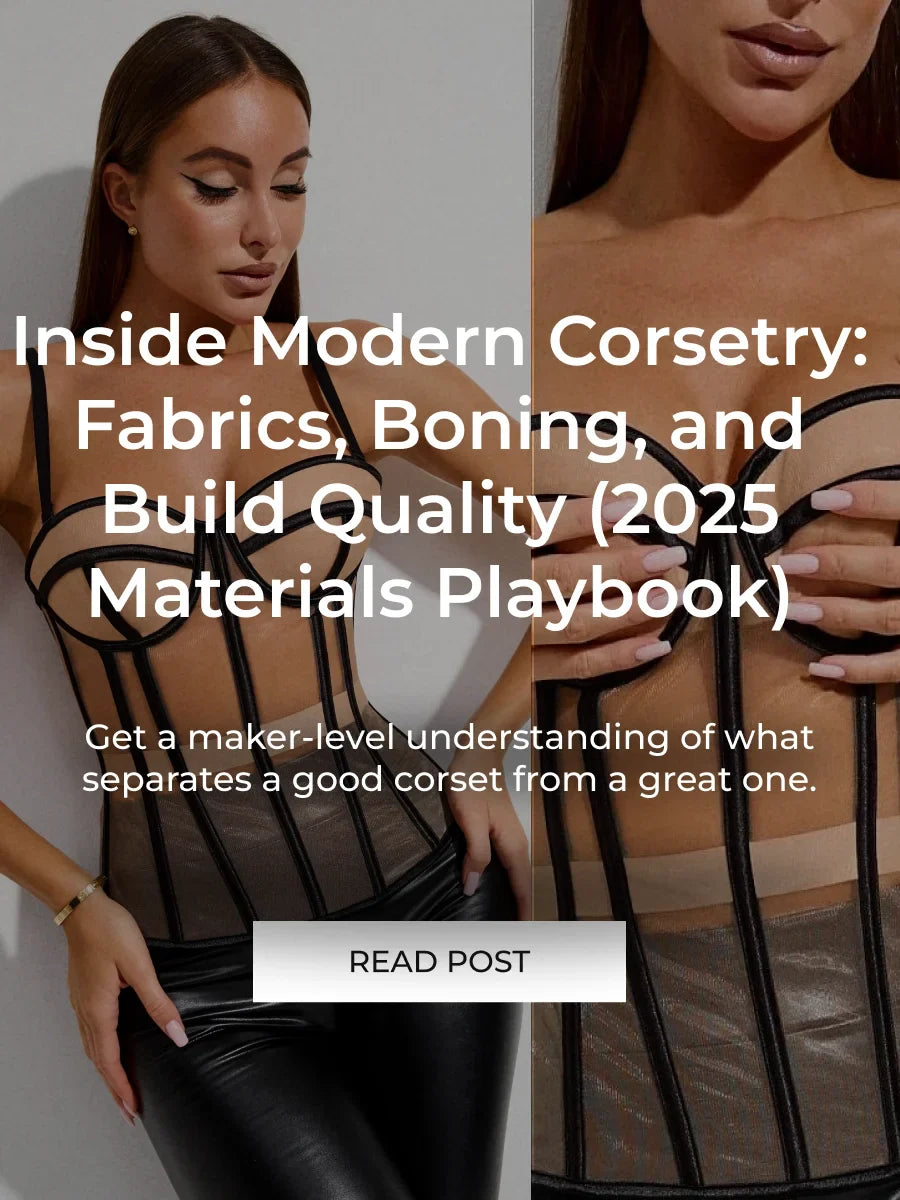Get a maker-level understanding of what separates a good corset from a great one. We’ll decode fabrics, boning, linings, closures, sustainability, and lab-grade quality checks so you can buy (or design) with confidence—across lace corset, satin corset, mesh corset, denim, and sequin builds.
Why Materials Matter More Than You Think
Two corsets can look identical but perform wildly differently. Fabric weave, boning rigidity, lining glide, and grommet reinforcement determine:
-
Comfort (breathability, stretch recovery)
-
Shape (how well curves are sculpted and held)
-
Durability (resistance to warping, popping seams, or chipped grommets)
-
Care (how forgiving it is to sweat, travel, or quick cleaning)
A modern corset should balance support and wearability—with components chosen intentionally for the use case (daily wear vs. editorial, summer heat vs. winter layering).
Fabric Families: Pros, Cons, and Use Cases
| Fabric | Handfeel | Pros | Watch Outs | Best Use |
|---|---|---|---|---|
| Lace (with soft backing) | Delicate, textured | Elevated look, breathable, romantic | Needs stable base to prevent distortion | Lace corset for events/bridal/date nights |
| Satin (stretched or woven) | Smooth, light sheen | Photographs luxuriously, glides under layers | Shows creases if over-tight; needs good interlining | Satin corset for polished/formal styling |
| Mesh (power mesh) | Airy, resilient | Superb airflow, flexible fit, daily comfort | Choose high-denier mesh; cheap mesh bags out | Mesh corset for warm climates & long wear |
| Denim (premium) | Structured, matte | Casual-chic, holds shape, ages well | Low give; fit must be dialed in | Streetwear & capsule wardrobes |
| Sequin/Embellished | Textured, reflective | High-impact look, party-ready | Weight, scratch potential; lining is key | Parties, shoots, evening |
| Cotton Sateen/Twill | Soft, structured | Skin-friendly, easy care | Can look casual without sheen | Everyday, layering |
Pro tip: A high-quality outer fabric is only half the story—ask what’s underneath (linings, interlinings, and boning channels).
Boning 101: Types, Tension, and Placement
Purpose: Distribute tension, support posture, and contour the torso.
-
Spiral Steel: Flexible in multiple directions; great for curved seams and mobility (dancing, sitting).
-
Flat Steel: Very supportive along vertical lines; ideal at center front/back to resist rolling.
-
High-Resilience Synthetic (e.g., premium poly boning): Lightweight, travel-friendly; choose brands that resist permanent kinks.
-
Rigilene (budget polyester): OK for light fashion corsets; avoid for serious shaping.
Placement Map (typical):
-
Center front: flat steel to keep the busk/zip stable
-
Side seams: spiral steel for movement
-
Princess seams: spiral steel for curve smoothing
-
Center back (lacing): flat steel for even tension
Linings & Interlinings: Comfort Meets Structure
-
Lining (against skin): Cotton sateen or silky hypoallergenic blends reduce friction and manage moisture.
-
Interlining (hidden middle layer): Adds strength and shape memory (coutil, fused twill, or stabilizing mesh).
-
Modesty Panel: Under the lacing to protect skin and ensure a smooth back profile.
Rule: If the outer is delicate (lace, sequin), inner layers must carry the structural load.
Closures & Hardware: Zippers, Grommets, Lacing
-
Side Zipper: Convenience; always lace first, then zip; look for hidden, reinforced zips.
-
Front Busk (classic): Vintage vibe, very strong when combined with flat steel.
-
Grommets/Eyelets: Rust-resistant metals; reinforced with extra layers; spacing should be even to avoid “V-gap.”
-
Laces: Textured ribbon or corded lacing; aim for waist pull loops in the middle for even tightening.


